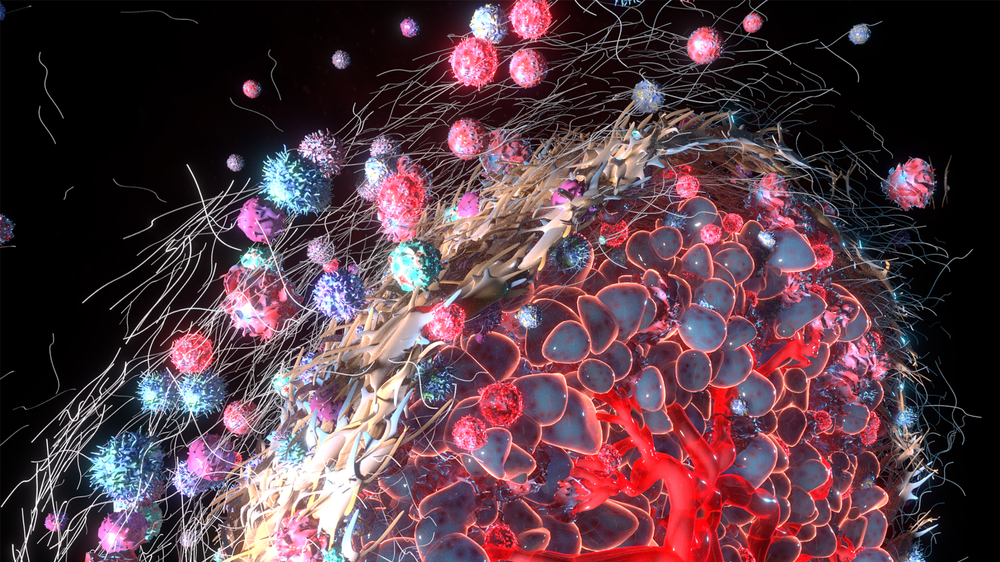Newsletter Signup - Under Article / In Page
"*" indicates required fields
CatalYm has published preclinical data in Nature Communications that reveal the central role of Growth Differentiation Factor-15 (GDF-15) in the resistance of tumors to current immunotherapy.
CatalYm said the findings further highlight the therapeutic significance of its proprietary anti-GDF-15 antibody candidate, visugromab, currently in advanced phase 2 clinical studies.
The foundational research, which was performed with founder Jörg Wischhusen and collaborators, is the first to describe a mechanistic link between tumor-produced GDF-15 and the LFA-1/ICAM-1 cell adhesion axis. The interaction between LFA-1/ICAM-1 is a critical step in the infiltration of T cells into the tumor microenvironment.
This is essential for the extravasation of T cells from the blood vessels into the surrounding tissue. GDF-15 is primarily known for its function in feto-maternal tolerance, an immunosuppressive mechanism that protects the fetus from the mother’s immune system.
CatalYm findings
The researchers demonstrated that GDF-15 blocks LFA-1-dependent T cell recruitment into the tumor microenvironment, a prerequisite for responses to anti-PD-1/-L1 treatment but also other immunotherapeutic strategies. Conversely, the blockade of GDF-15 with antibodies like the anti-GDF-15 antibody visugromab improved T cell infiltration into tumors.
Combined with a PD-1 inhibitor, it increased tumor clearance and survival with a synergistic effect. In line with these findings, serum analysis of melanoma patients showed that response to anti-PD-1 negatively correlates with GDF-15 serum levels. Therefore, GDF-15 serum levels may be a predictive biomarker for the response to anti-PD-1 therapy and overall survival in these patients.
Promising approach to tumor treatment
These findings further underscore the immunosuppressive role of GDF-15 in the tumor and contribute to the growing body of data supporting GDF-15-neutralizing therapy as a promising approach for hard-to-treat tumors resistant or refractory to anti-PD-1/-L1 treatment.
“Our publication is the first to demonstrate the effect of tumor-derived GDF-15 on the LFA-1/ICAM-1 axis. As this axis orchestrates cell-cell-interactions that are essential for immune-mediated tumor control, GDF-15 likely contributes to immune escape across many different tumors and therapies,” said Jörg Wischhusen, co-founder of CatalYm and professor at the University Hospital/Julius-Maximilians-University Würzburg, who is the senior author of the publication.
“Unraveling the details of the underlying biologic pathways is crucial to develop effective therapeutic approaches that can reverse tumor-mediated immunosuppression resulting in drug resistance, one of the major challenges in cancer medicine. We are committed to rapidly advancing our Phase 2 evaluation of visugromab on our mission to expand the treatment horizon for current and future immunotherapies,” added Christine Schuberth-Wagner, chief scientific officer at CatalYm.
The published data adds further valuable mechanistic understanding to the clinical findings from CalaYm’s GDFather (GDF-15 Antibody-mediaTed Human Effector Cell Relocation) trials with visugromab in combination with the anti-PD-1 inhibitor nivolumab in patients with advanced solid tumors.
Data by late 2023
Phase 1 study results announced in September 2022 showed an excellent safety and tolerability profile as well as significant clinical benefit in last-line tumor patients that were anti-PD-1/-L1 relapsed or refractory.
Interim data from the phase 2 trial continue to demonstrate a very good safety and tolerability profile and promising early responses in major cancer indications, including non-small cell lung cancer (NSCLC), bladder cancer and hepatocellular carcinoma (HCC). Mature data readouts for efficacy and safety data of the core phase 2a program as well as main biomarker-correlations are expected to become available by late 2023.
In November, the company raised €50 million to support its clinical trials. At the time of the financing, Phil L’Huillier, chief executive officer at CatalYm, said visugromab is “…emerging as a new anti-cancer immunotherapeutic drug with the potential to transform the immuno-oncology landscape.”
Oncology R&D trends and breakthrough innovations







